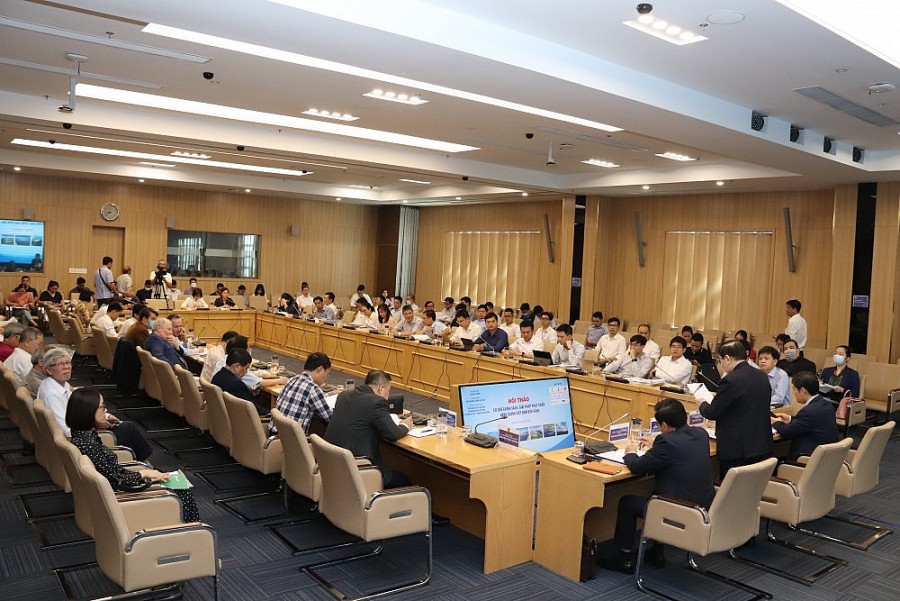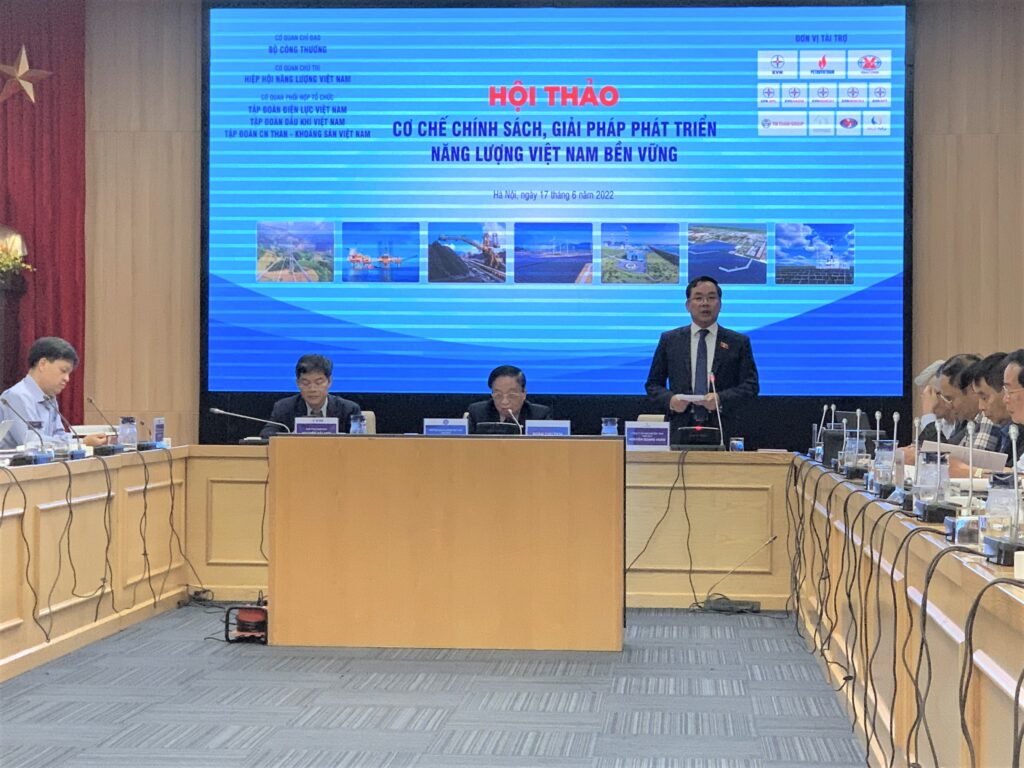The need for a comprehensive solution for sustainable energy development in Vietnam is the commonly shared viewpoint of experts and enterprise representatives at the Conference “Mechanisms, policies, solutions for sustainable energy development in Vietnam” organized by the Vietnam Energy Association on the morning of June 17, 2022, in Hanoi.
Attending the seminar were representatives of the National Assembly’s Committee on Science, Technology and Environment, representatives of the Vietnam Energy Association, representatives of the Electricity of Vietnam, domestic and foreign experts as well as enterprises working in the energy sector.
In recent years, the State has encouraged the development of wind power and solar power with very attractive electricity purchase prices (9.35 US cents/kWh for solar power; 8.8 US cents/kWh for wind power). With this mechanism, only in a short time, investors have massively implemented wind power, solar power and rooftop solar power projects, adding more capacity to Vietnam’s electricity system. Currently, the ratio of wind power and solar power accounts for about 27% of the total system capacity.
The conference clarified the outstanding issues of the Expanded Power Master Plan VII such as: The reason why the progress of many projects in the Expanded Power Master Plan VII has been delayed, many of which are delayed by several decades, such as: Thai Binh 2 Thermal Power Project; The largest series of hydrogen power projects is Block B-O Mon and Ca Voi Xanh – Quang Nam, Quang Ngai…, from which to gain experience to implement Power Master Plan VIII. The conference also analyzed the mechanisms and policies, challenges in terms of investment capital, the orders from top to bottom; to draw lessons for future projects.

Talking about the above issue, Mr. Tran Viet Ngai, Chairman of the Vietnam Energy Association said: “There are 3 decisive factors of a project: Capital is the first factor, the second is the policy mechanism, the third is orders and leadership from the central to local levels, to investors and contractors.”
“Effective mechanisms are necessary to continue mobilizing capital to exploit the potential and strengths of Vietnam’s renewable energy, in line with the orientation of reducing greenhouse gas emissions,” said Mr. Tran Viet Ngai.
The Institute of Energy has proposed an energy transition scenario with a total power capacity of 145,185 MW in 2030 and 413,054 MW in 2045. In which, there will be a gradual transition from coal-fired power sources to biomass and ammonia, and from LNG thermal power sources to hydrogen. In addition, eliminating 6 coal-fired power projects that have not been implemented with a total capacity of 8,800 MW; well-proportioning 10 coal-fired projects and LNG thermal power projects under preparation for investment with a total capacity of 10,842 MW.
From the experience of several delayed projects in the expanded Power Master Plan VII, some projects under preparation for investment in the draft Power Master Plan VIII as well as the proportion of wind and solar power accounting for about 27% of the total capacity. Nguyen Quang Huan, Chairman of Halcom Vietnam Joint Stock Company, said: “It is a big challenge to both ensure zero net emissions and maintain economic growth at the same time.”
Mr. Huan also pointed out two major obstacles: What actions needed to ensure development when renewable energy sources are not stable? What is the cost for using power storage if Vietnam adopts this solution without the ability to produce and localize it, and what is the challenge of its waste treatment after the depreciation is over? Because all this will affect the cost of electricity production and the price of electricity must be suitable for the payment conditions of the people as well as to ensure the development of the economy.
Besides, during the transition of coal-fired power plants, where will the workers be transferred to and what they will do while the newly-produced output of ammonia can only meet 20% of the needs of the transitioned plants and what is the roadmap for transition?
“We must have an overall strategy for Vietnam’s energy industry to develop sustainably. Experts need to come up with a suitable model to reduce emissions while ensuring economic development. Emissions reduction is the pressing need for every industry, not only the energy industry. Should we generate baseload power or buy a storage? The hydroelectric power source has been exploited to the limit, if we reduce coal power, what power source will we use instead?” said Mr. Huan.

Assoc. Prof. Dr. Nguyen Minh Due said that in reality, the energy industry in general and the electricity industry in particular need huge capital to ensure energy security development and energy sustainability of Vietnam. According to the expanded Power Master Plan VII, we need an investment capital of 7.9 billion USD/year for 2016-2020, 10.8 billion USD/year for 2021-2030, according to the Draft Power Plan VIII, from 2021-2030 is 12.8 billion USD/year. That is an enormous amount of capital…
According to Mr. Nguyen Tai Anh – Deputy General Director of Electricity of Vietnam: “Currently, we have about 21,000 MW of renewable energy, which is equivalent to 27% in the power source structure, while other ASEAN countries set a target of about 20%.”
“The installed capacity of wind power in Vietnam is about 4,000 MW. However, the data in April and May show that the power generation capacity fluctuates dramatically daily, sometimes it reaches just over 300 MW, and there is almost no wind from time to time,” said Mr. Tai Anh.
Mr. Tai Anh also said that the Power Master Plan VIII, which is being compiled, has set out solutions for power sources to make electricity costs reasonable…
Mr. Ly Anh Dung, from Hanoi University of Science and Technology, said: “Energy security policy is important to all countries, but to achieve the goal of zero emissions by 2050, there must be the participation of economic sectors, not only the electricity sector. We must clarify the emission levels for economic sectors; and mobilize sectors and resources to participate in emission reduction. And how much emission reduction rate of sectors such as: Transport, industry, construction, agriculture… we must clarify.”
Mr. Ta Dinh Thi – Vice Chairman of the National Assembly’s Committee on Science, Technology and Environment shared: “I found that the discussion in the seminar today is very meaningful, but there are some emerging issues that need to be discussed. The world is changing and our policy needs changing accordingly. Currently, the Draft Oil and Gas Law is being submitted to the National Assembly for consideration, along with the plan to amend the Electricity Law, the Law on Economical and Efficient Use of Energy… All of these issues are aiming at economy development in the context of the everchanging world. Article 4 – Law on Electricity, for example, has been amended to mobilize non-state resources in investment and development of the power grid…”
The conference analyzed specific practical issues through Vietnam’s energy development in reality, including hydrogen power, other energy projects such as coal, biomass, solar power, onshore and offshore wind power.
Source: Official Media Agency of the Ministry of Industry and Trade
News reference:
